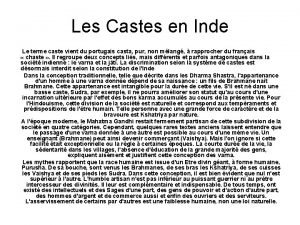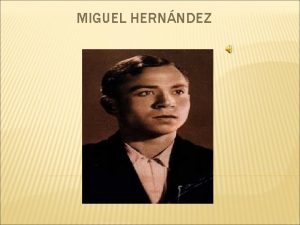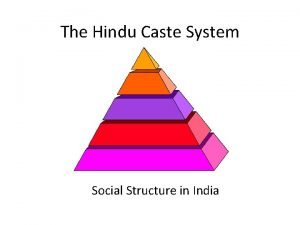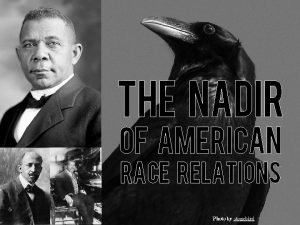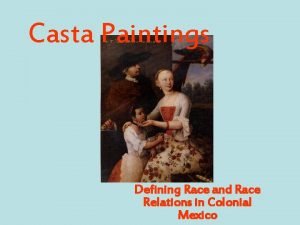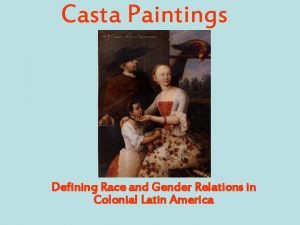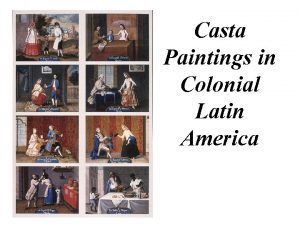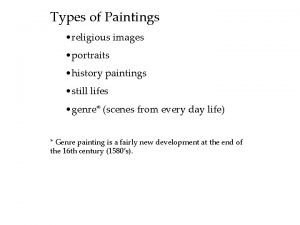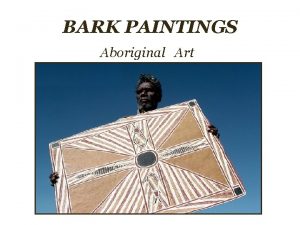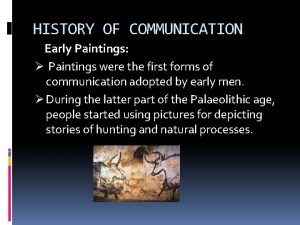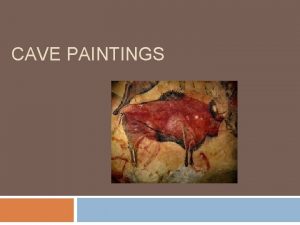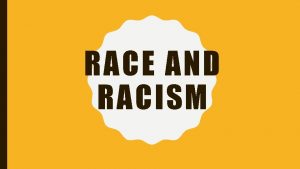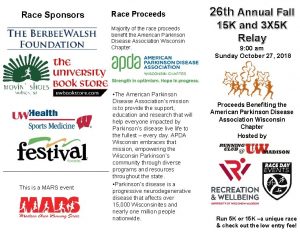Casta Paintings Defining Race and Gender Relations in
















- Slides: 16

Casta Paintings Defining Race and Gender Relations in Colonial Latin America

Origins of “Casta” • Casta is an Iberian word meaning “lineage”, “breed” or “race. ” • It is derived from the older Latin word castus, “chaste”, implying that the lineage has been kept pure.

Defining castas in Latin America • In the years following the conquest of the Americas, most people fell into three distinct ethnoracial categories: Nahuas (indigenous people), peninsular Spaniards, or Africans (both enslaved and free). • By the early 17 th century, these categories broke down quickly and castas were being defined. Some estimates place the total number of castas in use in colonial Latin America at sixty or more.

Casta Paintings • Casta paintings are part of the 18 th century artistic tradition of Colonial Mexico. • These generally appear in groups of sixteen portraits that trace the complex racial mixing or mestizaje of the people in New Spain. • Each painting depicts a couple along with one or two children. • An inscription describing the ethnoracial make up of the mother, the father, and the child(ren) usually appears above the family.

Maintaining social and political control in Colonial New Spain Spaniards used their elaborate system of classification to maintain social and political control, allowing only the “pureblooded” to hold the top positions in colonial society.

How to Analyze Casta Paintings What Do You See? • Who is in the painting? • What are they doing? • What are they wearing? • How does their environment look? What Do Observations Mean? • Are the males & females doing similar or different things? • Do actions depend on racial categories? • Do clothing & environments change depending on race & class?

#1 - Spaniard & Native Create Mestizo

#2 - Spaniard & Mestiza Create Castiza

#3 - African & Spaniard Create Mulatto

#4 - Mestizo & Indian Create Coyote

#5 - Mulatto & Spaniard Create Morisco

#6 - Spaniard & Morisca Create Albino

#7 - Spaniard & Albino Create Black-Return. Backwards

#8 - African & Indian Create Wolf

#9 - Wolf & Indian Create Zambaiga

#10 – Zambaigo & Indian Create Albarazado
 Relative pronouns defining and non-defining
Relative pronouns defining and non-defining Relative clauses defining and non defining
Relative clauses defining and non defining Non defining relative clauses as sentence modifiers
Non defining relative clauses as sentence modifiers Defining relative clause meaning in telugu
Defining relative clause meaning in telugu Essential adjective clause
Essential adjective clause Relative clauses örnekleri
Relative clauses örnekleri Reaction and impulse turbine difference
Reaction and impulse turbine difference Design of dams
Design of dams Strategic gender needs and practical gender needs
Strategic gender needs and practical gender needs Casta esteban y navarro
Casta esteban y navarro Inde
Inde Illud in his rebus vereor metrica
Illud in his rebus vereor metrica No me conformo no me desespero
No me conformo no me desespero India caste system today
India caste system today Casta system
Casta system Data race vs race condition
Data race vs race condition Nadir of race relations
Nadir of race relations










